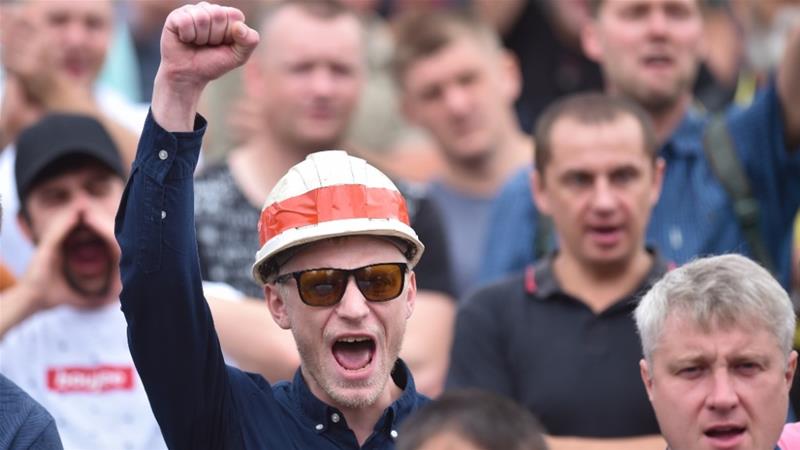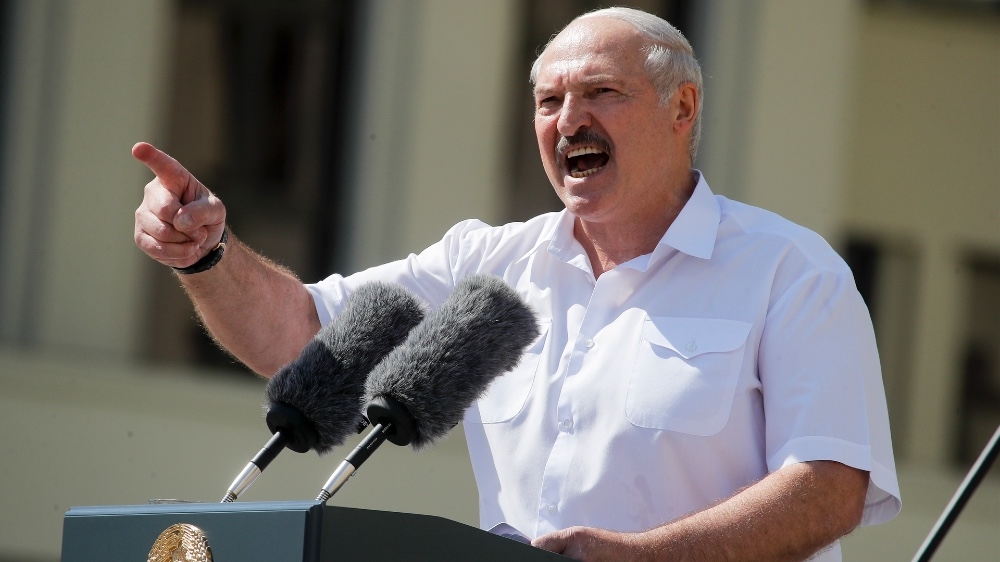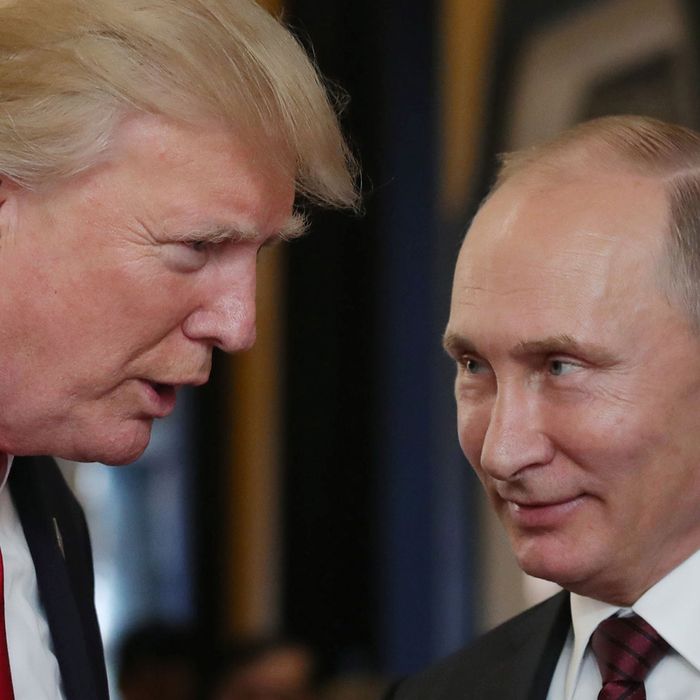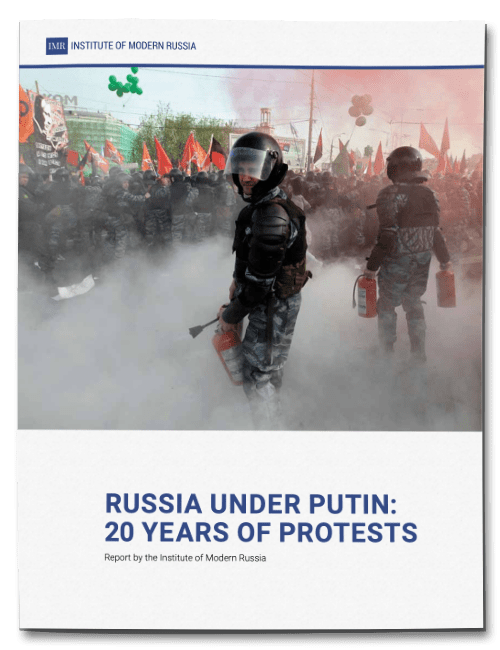President Alexander Lukashenko's crackdown on anti-government protesters stoke fears of a Ukrainian scenario in Belarus.
by Mariya Petkova
8/19/2020

Despite the growing opposition against his rule, Lukashenko has remained defiant [Sergei Gapon/AFP]
When Belarusians came out on August 9 to protest what they saw as a mass falsification of the presidential elections, Marat Mikhal knew that a violent police crackdown was imminent. It had happened before.
In December 2010, after President Alexander Lukashenko claimed 80 percent of the votes in the presidential election amid allegations of vote-rigging, protests erupted in the capital Minsk but were swiftly suppressed by police forces.
The events of that year affected Mikhal, who was then just 16 years old, and politicised him.
Ten years later, as a young adult, he came out in the streets of Minsk to protest Lukashenko's fifth re-election, despite the heavy police presence. He was arrested, severely beaten and held in detention for several days.
The violence, however, did not deter Mikhal and many others from continuing to protest against Lukashenko.
"My relatives urged me [not to join the protests again]. But if not me, then who would? So I went out to protest despite [the warnings]," Mikhal told Al Jazeera.
On August 16, he joined more than 200,000 people who gathered in central Minsk for what some say has been the largest opposition demonstration in the recent history of Belarus.
Meanwhile, workers at various state factories and institutions announced strikes in solidarity with protesters, while videos of members of the security forces announcing their resignations circulated on social media.
Lukashenko's defiance
Despite the growing opposition against his rule, Lukashenko has remained defiant.
He has rejected calls to hold new elections and has instead proposed to amend the constitution in order to redistribute executive power.
When Belarusians came out on August 9 to protest what they saw as a mass falsification of the presidential elections, Marat Mikhal knew that a violent police crackdown was imminent. It had happened before.
In December 2010, after President Alexander Lukashenko claimed 80 percent of the votes in the presidential election amid allegations of vote-rigging, protests erupted in the capital Minsk but were swiftly suppressed by police forces.
The events of that year affected Mikhal, who was then just 16 years old, and politicised him.
Ten years later, as a young adult, he came out in the streets of Minsk to protest Lukashenko's fifth re-election, despite the heavy police presence. He was arrested, severely beaten and held in detention for several days.
The violence, however, did not deter Mikhal and many others from continuing to protest against Lukashenko.
"My relatives urged me [not to join the protests again]. But if not me, then who would? So I went out to protest despite [the warnings]," Mikhal told Al Jazeera.
On August 16, he joined more than 200,000 people who gathered in central Minsk for what some say has been the largest opposition demonstration in the recent history of Belarus.
Meanwhile, workers at various state factories and institutions announced strikes in solidarity with protesters, while videos of members of the security forces announcing their resignations circulated on social media.
Lukashenko's defiance
Despite the growing opposition against his rule, Lukashenko has remained defiant.
He has rejected calls to hold new elections and has instead proposed to amend the constitution in order to redistribute executive power.
VIDEO
No more fear!': Belarus president heckled by striking workers (2:32)
He has also reached out to Russia's President Vladimir Putin to request help, which has stirred fears of possible Russian military intervention, similar to the one in Ukraine in 2014.
But according to analysts, what happens next in Belarus will be determined not just by decisions made in Moscow, but also by the resilience of protesters like Mikhal and their ability to maintain mass mobilisation on the ground.
Although Lukashenko is seeking help from the Kremlin, he is not on the best of terms with the Russian leadership.
In recent years, the Belarusian president has shifted between anti-Russian and anti-Western rhetoric, trying to exploit Russian-EU tensions to secure oil and gas price discounts from Moscow.
In pursuing this strategy, Lukashenko is said to have incurred Putin's resentment.
A rejected union
Earlier this year, Moscow announced that Belarus would start paying for Russian oil and gas at global prices after the Belarusian president resisted Russian pressure to go forward with a union between the two countries.
In 1999, Lukashenko had signed an agreement with then-Russian President Boris Yeltsin for the creation of a political and economic union, where the two countries would have common political institutions, economic policies, and currency.
The agreement was never fully implemented, but close ties to Moscow ensured the flow of cheap Russian oil and gas, which propped up the country's economy and precluded the need for privatisation of state-owned enterprises and political opening.
In the 2010s, as the Russian economy was hit by the slump in oil prices and Western sanctions, the Kremlin found it difficult to sustain subsidies for Belarus and sought to change this arrangement.

Opposition supporters take part in a protest rally in front of the parliament building in Minsk [Tatyana Zenkovich/EPA]
In response, Lukashenko pursued closer relations with the West, which led to the European Union lifting most sanctions on Belarus.
From Moscow's perspective, a union with Belarus would have justified the continuation of subsidies, but Lukashenko saw this as a direct threat to his power.
Before the August 9 vote, the Belarusian president repeatedly accused Russia of supporting the opposition.
On July 29, the Belarusian authorities arrested dozens of Russian citizens, claiming they were mercenaries from Russia's best-known private military contractor, Wagner, who were preparing a plot to destabilise the country.
As it became clear that the crackdown was not effective in suppressing the protests, Lukashenko switched to anti-Western rhetoric.
He has since accused the opposition of planning to join NATO and the European Union, ban the Russian language, and establish an Orthodox church independent of the Moscow Patriarchate - policies that Ukrainian nationalists have pursued since 2014, angering Russia.
Since the elections, he has also had at least two phone calls with Putin to discuss Russian assistance in case of a "foreign threat".
On August 18, he spoke for a third time with the Russian president, who informed him of his conversations with German Chancellor Angela Merkel and French President Emmanuel Macron regarding the situation in Belarus.
The same day, Russian media reported that an aeroplane belonging to the Russian security service FSB and previously used by FSB director Alexander Bortnikov had landed in Minsk, but no details were provided on any formal meeting between Lukashenko and Russian officials.
A Ukraine scenario
While Lukashenko's about-face has provoked fears of a Ukrainian scenario in Belarus, a Russian military intervention does not seem to be forthcoming.
According to Anton Barbashin, a research fellow at the Atlantic Council, apart from the Kremlin's dislike for the Belarusian president, what also makes such a scenario unlikely is the fact that any military action would be very costly for the Russian leadership.
He has also reached out to Russia's President Vladimir Putin to request help, which has stirred fears of possible Russian military intervention, similar to the one in Ukraine in 2014.
But according to analysts, what happens next in Belarus will be determined not just by decisions made in Moscow, but also by the resilience of protesters like Mikhal and their ability to maintain mass mobilisation on the ground.
Although Lukashenko is seeking help from the Kremlin, he is not on the best of terms with the Russian leadership.
In recent years, the Belarusian president has shifted between anti-Russian and anti-Western rhetoric, trying to exploit Russian-EU tensions to secure oil and gas price discounts from Moscow.
In pursuing this strategy, Lukashenko is said to have incurred Putin's resentment.
A rejected union
Earlier this year, Moscow announced that Belarus would start paying for Russian oil and gas at global prices after the Belarusian president resisted Russian pressure to go forward with a union between the two countries.
In 1999, Lukashenko had signed an agreement with then-Russian President Boris Yeltsin for the creation of a political and economic union, where the two countries would have common political institutions, economic policies, and currency.
The agreement was never fully implemented, but close ties to Moscow ensured the flow of cheap Russian oil and gas, which propped up the country's economy and precluded the need for privatisation of state-owned enterprises and political opening.
In the 2010s, as the Russian economy was hit by the slump in oil prices and Western sanctions, the Kremlin found it difficult to sustain subsidies for Belarus and sought to change this arrangement.

Opposition supporters take part in a protest rally in front of the parliament building in Minsk [Tatyana Zenkovich/EPA]
In response, Lukashenko pursued closer relations with the West, which led to the European Union lifting most sanctions on Belarus.
From Moscow's perspective, a union with Belarus would have justified the continuation of subsidies, but Lukashenko saw this as a direct threat to his power.
Before the August 9 vote, the Belarusian president repeatedly accused Russia of supporting the opposition.
On July 29, the Belarusian authorities arrested dozens of Russian citizens, claiming they were mercenaries from Russia's best-known private military contractor, Wagner, who were preparing a plot to destabilise the country.
As it became clear that the crackdown was not effective in suppressing the protests, Lukashenko switched to anti-Western rhetoric.
He has since accused the opposition of planning to join NATO and the European Union, ban the Russian language, and establish an Orthodox church independent of the Moscow Patriarchate - policies that Ukrainian nationalists have pursued since 2014, angering Russia.
Since the elections, he has also had at least two phone calls with Putin to discuss Russian assistance in case of a "foreign threat".
On August 18, he spoke for a third time with the Russian president, who informed him of his conversations with German Chancellor Angela Merkel and French President Emmanuel Macron regarding the situation in Belarus.
The same day, Russian media reported that an aeroplane belonging to the Russian security service FSB and previously used by FSB director Alexander Bortnikov had landed in Minsk, but no details were provided on any formal meeting between Lukashenko and Russian officials.
A Ukraine scenario
While Lukashenko's about-face has provoked fears of a Ukrainian scenario in Belarus, a Russian military intervention does not seem to be forthcoming.
According to Anton Barbashin, a research fellow at the Atlantic Council, apart from the Kremlin's dislike for the Belarusian president, what also makes such a scenario unlikely is the fact that any military action would be very costly for the Russian leadership.
Belarus president claims he is willing to share power (5:18)
It would mean further deterioration in relations with the West and more heavy sanctions.
Although Lukashenko is trying to stir fears of anti-Russian sentiment and actions by the opposition, the Belarusian protests have not adopted any nationalistic narratives that would alienate the Russian-speaking communities in the country and encourage local support for Russian military action, Barbashin said.
And while Belarus falls within the Russian sphere of influence and regional security calculus, it has no major Russian military base, unlike the Crimean Peninsula in Ukraine, which was annexed by Russia in 2014.
In Barbashin's opinion, an "Armenian scenario" is more likely than a Ukrainian one.
In 2018, a nationwide protest movement toppled Armenian Prime Minister Serzh Sargsyan after he sought to remain in power despite previous pledges to step down.
Although Sargsyan had warm ties with Moscow, the Russian government did not oppose the protests, which had not expressed any anti-Russian sentiment.

Lukashenko addresses his supporters gathered at Independent Square of Minsk [Dmitri Lovetsky/AP]
Belarusian protesters and opposition candidate Svetlana Tikhanovskaya have repeatedly emphasised that they do not want a "Maidan" in Belarus, referring to the protest movement in Ukraine in 2013-2014.
At an August 18 news conference of the coordination committee for the transfer of power, formed by Tikhanovskaya's campaign, its members expressed commitment to maintaining close relations with Russia.
Similar sentiments have been voiced by protesters who, unlike their Ukrainian counterparts, have not raised the EU flag during rallies or called for Euro-Atlantic integration.
Mikhal told Al Jazeera that he does not want Belarus to become a battlefield for the Russia-EU standoff and hopes that his country will be able to maintain neutrality and good relations with both.
It would mean further deterioration in relations with the West and more heavy sanctions.
Although Lukashenko is trying to stir fears of anti-Russian sentiment and actions by the opposition, the Belarusian protests have not adopted any nationalistic narratives that would alienate the Russian-speaking communities in the country and encourage local support for Russian military action, Barbashin said.
And while Belarus falls within the Russian sphere of influence and regional security calculus, it has no major Russian military base, unlike the Crimean Peninsula in Ukraine, which was annexed by Russia in 2014.
In Barbashin's opinion, an "Armenian scenario" is more likely than a Ukrainian one.
In 2018, a nationwide protest movement toppled Armenian Prime Minister Serzh Sargsyan after he sought to remain in power despite previous pledges to step down.
Although Sargsyan had warm ties with Moscow, the Russian government did not oppose the protests, which had not expressed any anti-Russian sentiment.

Lukashenko addresses his supporters gathered at Independent Square of Minsk [Dmitri Lovetsky/AP]
Belarusian protesters and opposition candidate Svetlana Tikhanovskaya have repeatedly emphasised that they do not want a "Maidan" in Belarus, referring to the protest movement in Ukraine in 2013-2014.
At an August 18 news conference of the coordination committee for the transfer of power, formed by Tikhanovskaya's campaign, its members expressed commitment to maintaining close relations with Russia.
Similar sentiments have been voiced by protesters who, unlike their Ukrainian counterparts, have not raised the EU flag during rallies or called for Euro-Atlantic integration.
Mikhal told Al Jazeera that he does not want Belarus to become a battlefield for the Russia-EU standoff and hopes that his country will be able to maintain neutrality and good relations with both.
Fear of prosecution
Although military intervention from Russia remains unlikely, Lukashenko's resignation is also far from certain.
According to Aleksey Bratochkin, a historian and lecturer at the European College of Liberal Arts in Belarus, what is making his exit more difficult is his fear of prosecution.
During his 26-year rule, many crimes have been committed that could lead to criminal investigations, including the forced disappearances of a number of politicians, businessmen and journalists who had been critical of his presidency.
"There are many claims against Lukashenko from various political groups. He is not a president who would retire peacefully," Bratochkin said.
Although pressure from the streets has increased since the August 9 vote, the foundations of Lukashenko's rule still seem intact.
While there have been some resignations among low-ranking officials and members of the security forces, no significant defections from the political elite have taken place, Bratochkin said.
Lukashenko has also rejected negotiations with Tikhanovskaya, calling the formation of the coordination committee "an attempt to seize power" and threatening its members with legal action.
The elites
There is also continuing heavy security presence in Minsk and elsewhere in the country, which is raising fears that the president could resort to violence again at any time.
According to Katia Glod, a London-based scholar and consultant on former Soviet countries, Lukashenko's current strategy is to protract the political process and wait for the protests to dissipate.
VIDEO Belarus president says Putin ready to help 'ensure security' (2:50)
To counter his intransigence, the opposition would have to find a political insider who has more authority and standing to lead negotiations with him and his elite, she said.
"[The elites] know that Lukashenko has some compromising materials against them. They understand that if they defect, they would lose their economic [benefits]," Glod said.
"They would not do it, unless there is someone very credible and strong who can persuade them and give them certain guarantees," she said.
In her view, pressure from the EU in the form of sanctions and refusal to recognise Lukashenko's government could also encourage negotiations, but ultimately the outcome of the current standoff will be determined by the opposition movement's ability to find allies within the political elite and sustain mass mobilisation.
According to Mikhal, there is such a society-wide consensus against Lukashenko's rule that the protest momentum is unlikely to slow down.
"In 2010, the society swallowed [the falsification of the vote], but today it is no longer the same society. It has matured politically", he said. "The current situation will only end if there is handover of power."








